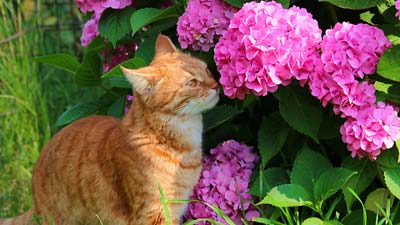Understanding the Third Eyelid in Cats and Underlying Health Concerns

What Is the Third Eyelid in a Cat?
The feline eye does indeed have a third eyelid called the nictitating membrane. This membrane is a thin, translucent tissue that is located in the inner corner of the eye. The primary function of the nictitating membrane is to provide additional protection to the eye by moistening and cleaning it.
While it is not always visible, it can be seen when the cat is experiencing certain emotions or in certain situations, such as when they are feeling sleepy or are sick. However, its emergence can often signal underlying health concerns warranting attention and care.
Reasons for the Emergence of the Third Eyelid:
The sighting of a cat's third eyelid is an unusual occurrence and often indicative of an underlying issue warranting attention.
Normal Circumstances:
Sleepiness and Relaxation
During moments of profound relaxation or fatigue, glimpses of the third eyelid may manifest, portraying a cat's tranquility or slumber. It's not uncommon to observe this occurrence when a cat dozes or right after awakening. Typically, the third eyelid retracts promptly as the cat transitions to a state of alertness.
Post-Sedation or Anesthesia
Following the administration of sedation or anesthesia for medical procedures, the third eyelid may emerge, partially veiling the eye due to profound physical relaxation. This phenomenon, persisting for several hours post-awakening, generally subsides gradually. However, if the third eyelid lingers in a raised position beyond the day of the procedure, seeking veterinary guidance becomes imperative.
Abnormal Protrusion: Underlying Health Concerns
In instances where the third eyelid remains prominent for extended periods beyond sleep, relaxation, or medical interventions, it serves as a potential indicator of various health issues warranting professional evaluation.
Here are some potential possible issues:
1. Conjunctivitis: The Inflammation Factor
Conjunctivitis, characterized by inflammation of the thin, transparent membrane (conjunctiva) lining the inner eyelids and the eye's front part, might induce the protrusion of the third eyelid. This inflammation, caused by infections, allergies, injuries, or irritants, often necessitates treatment with medicated eye drops or ointments containing antibiotics or steroids.
2. Corneal Ulcers: Wounds to the Eye
Corneal ulcers, resulting from wounds or injuries to the eye's clear outer layer (cornea), evoke pain and inflammation, contributing to the third eyelid's emergence. These ulcers, potentially caused by scrapes, scratches, or foreign objects, require prompt veterinary attention. Treatment typically involves various eye medications and, in some cases, oral medications to address the condition effectively.
3. Uveitis: Inflammation of the Eye's Middle Layer
Inflammation of the uvea, the eye's middle portion housing numerous blood vessels, termed uveitis, occasionally triggers the appearance of the third eyelid. This condition, often characterized by redness and potential discomfort, might involve the third eyelid, albeit inconsistently.
5. Glaucoma: The Pressure Build-Up
Glaucoma, a painful eye disorder stemming from increased intraocular pressure due to inadequate fluid drainage, might coincide with inflammation of the third eyelid. This condition, culminating in optic nerve damage and potential blindness, occasionally accompanies third eyelid protrusion.
6. Cherry Eye: Gland Swelling
The third eyelid houses a gland susceptible to swelling, leading to a rounded protrusion recognized as a cherry eye. Although relatively uncommon in most cats but prevalent in certain breeds like Burmese, surgical intervention constitutes the primary treatment for cherry eye.
7. Eye Growths and Horner's Syndrome: Structural Abnormalities
Growths, tumors, cysts, or conditions like Horner's syndrome—a neurological disorder affecting eye and facial muscles—can prompt third eyelid inflammation or asymmetry in eye appearance.
Addressing Third Eyelid Protrusion:
When you notice your cat's third eyelid, seemingly unrelated to relaxation or anesthesia, seeking veterinary advice promptly is crucial. Additionally, if other signs of illness manifest, a prompt examination is essential. It's advisable to avoid applying any substances to the eye without veterinary guidance as this could exacerbate the issue. Eye concerns can deteriorate rapidly, underscoring the importance of timely veterinary attention.
You May Also Like
 Help & AdviceThe Toxic Truth: Why Are Hydrangeas Harmful to Cats?
Help & AdviceThe Toxic Truth: Why Are Hydrangeas Harmful to Cats? Cat BehaviorThe 7 Reasons Cats Bite, and How to Stop The Behavior
Cat BehaviorThe 7 Reasons Cats Bite, and How to Stop The Behavior Cat HealthCan Cats Catch Colds From Humans?
Cat HealthCan Cats Catch Colds From Humans? Cat HealthThe Cat's Nose Is Dry, Is It Sick?
Cat HealthThe Cat's Nose Is Dry, Is It Sick? Cat HealthIs A Cat's Nose Dry Or Wet and Why?
Cat HealthIs A Cat's Nose Dry Or Wet and Why? Help & AdviceHow Does Trimming A Cat's Whiskers Affect Cats?
Help & AdviceHow Does Trimming A Cat's Whiskers Affect Cats?